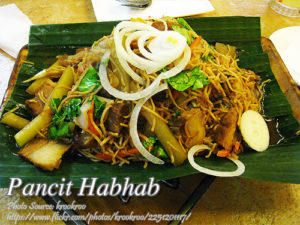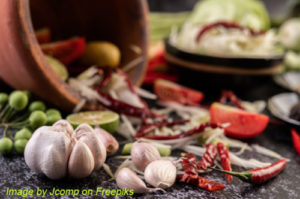This is a a tasty pancit sotanghon and suited to those who wants to refrain from eating meat, poultry or fish because this pancit dish contains only veggies. I think senior citizens will love this dish and specially those who visit this blog and my facebook page that complains or even makes mocking comments whenever I post meat dishes. In the first place, this blog is all about meat recipes so I think they are looking for something else and landed accidentally on my sites.
Anyway the main three ingredients here aside from the sotanghon noodles are carrots, tengang daga (cloud ear fungus) and kasubha (dried safflower). And what makes the flavor is the patis and the chicken broth. But in case you want to add more ingredients like shrimps, pork or other seafood, you can do it and will enhance the flavor. But in case you are using dried salted shrimps or hibe, after soaking the hibe in water, discard the liquid because the dish might become too salty.
Pancit Sotanghon: A Comforting Vegetable Delight
Growing up in a family where pancit was always the centerpiece of any celebration, I’ve come to love its endless variations. Whether it’s pancit canton loaded with meat or pancit palabok crowned with seafood, each one holds a special memory. But today, I’m sharing a meatless version of pancit sotanghon that my Auntie Lita introduced to us during one Lenten season when the whole family refrained from eating meat. It’s a dish so flavorful and hearty that even my uncle—who used to insist that pancit needed pork or chicken—was convinced otherwise.
A Noodle Dish That Brings People Together
Pancit sotanghon is one of those dishes that carry a lot of history. Derived from Chinese influence, it has evolved into a Filipino staple, often served during birthdays and fiestas for good luck. What makes this dish stand out is the use of sotanghon noodles, or glass noodles, which are light, silky, and perfect for soaking up flavors. This version, made entirely with vegetables, has become my go-to for days when I want something lighter yet just as satisfying.
Auntie Lita told me that back in her day, vegetables like carrots and tengang daga (cloud ear fungus) were inexpensive yet packed with nutrients, making them perfect for this kind of dish. She’d often garnish it with fried garlic for an extra layer of aroma and crunch, and this trick has stayed with me.
Why Blanching and Frying Techniques Work for Pancit Sotanghon
Blanching the carrots briefly in boiling water is a technique that Auntie Lita swore by. She explained that this method helps preserve the carrots’ vibrant orange color while slightly softening their texture. This way, they stay crisp and fresh even after being cooked with the noodles.
Another secret she passed on was frying the garlic until golden brown before starting the dish. Not only does it release an irresistible aroma that fills the entire kitchen, but it also serves as a delightful garnish that enhances the overall taste and presentation. Set aside some of this fried garlic for the final touch—it’s these little details that truly elevate the dish.
The Heart of the Dish: Sotanghon Noodles and Kasubha
The sotanghon noodles, made from mung bean starch, are the star of this dish. Soaking them briefly in tap water before cooking ensures they don’t turn mushy later. Auntie Lita used to cut the noodles into manageable lengths, saying it made the dish easier to eat—something that’s especially appreciated by kids and seniors alike.
Another ingredient that gives this pancit sotanghon its distinct golden hue is kasubha, or dried safflower. It’s a spice often used as a natural food coloring and lends a subtle, earthy flavor to the dish. I remember how Auntie Lita would soak kasubha in water first to extract its vibrant color before adding it to the wok. To me, this step always felt like a touch of magic, transforming the dish into a feast for the eyes as well as the palate.
A Versatile Dish for Every Occasion
While this version is purely vegetable-based, you can easily add other ingredients if you prefer. My cousin Jonjon likes to toss in shrimp when he’s feeling fancy, while my sister Carla swears by adding slices of boiled egg on top for a little protein. If you choose to use dried salted shrimp or hibe, remember to discard the soaking liquid to prevent the dish from becoming overly salty—a mistake I learned the hard way!
The chicken broth in the recipe provides a savory base, but you can swap it for vegetable broth to keep the dish entirely meat-free. And don’t skimp on the patis (fish sauce)! Auntie Lita always said it’s what gives pancit sotanghon that distinct umami flavor, tying all the ingredients together beautifully.
A Nostalgic Bowl of Comfort
Every time I cook this pancit sotanghon, I’m reminded of the lively kitchen conversations we used to have while preparing family meals. Auntie Lita would be peeling carrots while Uncle Bert teased her for making “vegetarian pancit,” and I’d be on garlic duty, frying batch after batch to perfection. The laughter, the stories, and the irresistible smell of sautéed garlic—it’s all part of the magic of this dish.
Pancit sotanghon, even without meat, is proof that simplicity can still deliver incredible flavor. Whether you’re making it for a special occasion or just a regular meal, it’s a dish that will leave everyone at the table satisfied. And who knows? It might just become your family’s new favorite, just as it did for mine.
So the next time you’re in the mood for something light yet hearty, give this recipe a try. Pair it with a side of calamansi for a zesty kick, and you’ve got a dish that’s both comforting and nourishing—a true classic that will never go out of style.
How to Cook Pancit Sotanghon
Ingredients
- 500 grams sotanghon noodles vermicelli
- 6 Tbsp. cooking oil
- 1 head garlic peeled and crushed
- 2 cups carrots peeled and julienned
- 1 Tbsp. garlic minced
- 1 cup red onions slice into thin wedges
- 10 grams kasubha or safflower first addition
- 1 tsp. freshly ground pepper
- 1/2 cup patis fish sauce
- 50 grams tengang daga soaked in hot water then chopped
- 1 cup spring onions chopped into 1/4 inch pieces
- 10 grams kasubha or safflower second addition
- 5 cups chicken broth or 5 cups water plus chicken bouillon
- 1 Tbsp. cooking oil
- salt and pepper to taste
Instructions
How to cook Pancit Sotanghon:
- Boil water in a pot and add a little salt. Blanch the carrots for about half a minute and remove the carrots from the boiling water and drain. Set aside.
- Soak the sotanghon noodles in tap water for 5 minutes or until they are tender enough to cut with a pair of scissors. Cut the noodles and set aside.
- Heat about 6 tablespoons of oil in a wok and saute 1 head of garlic until golden brown. Remove the garlic from the wok, drain excess oil and set aside. This will be used as garnishing when serving the sotanghon.
- In the same wok and oil where you fried the garlic, saute a tablespoon of garlic and onions until fragrant. Then soak the 10 grams of kasubha in water using a sieve then drain. Add the kasubha in the wok and saute together with the garlic and onions.
- Add in the 1 teaspoon ground pepper and the half a cup of patis. Let the patis boil before stirring. Then add the tengang daga in the wok and stir for a few seconds.
- Then add the blanched carrots and continue stirring while cooking. Add also some spring onions on the mixture and stir for half a minute. Turn off heat and transfer the mixture in a bowl and set aside.
- In the same wok with the patis still inside the wok, put another 10 grams of kasubha soaked in water. Turn on heat and let the liquid boil. Add in a tablespoon of cooking oil and 5 cups of chicken broth. Cover the wok and bring to a boil.
- Uncover and add in the sotanghon noodles and stir. Continue stirring until the sotanghon noodles almost absorbed all the liquid. Season with salt and pepper if desired.
- Put the sauteed vegetables back into the wok and toss until all the ingredients are well distributed with the noodles. Put the rest of the spring onions in the sotanghon mixture and continue tossing until done. Garnish with fried garlic when serving.
Notes
Cooking Tips:
Soak the Sotanghon Noodles Properly
Before cooking, soak the sotanghon noodles in tap water for about five minutes or until they become tender but not mushy. This helps prevent the noodles from absorbing too much liquid during cooking, which could make the dish overly soggy. Cutting the noodles into shorter lengths after soaking also makes them easier to toss and eat.Don’t Skip the Garlic Garnish
Frying garlic until golden brown not only enhances the aroma of the dish but also adds a delightful crunch. Set aside some of the fried garlic as a garnish to give the pancit a finishing touch that balances texture and flavor. This step may seem simple, but it elevates the dish from ordinary to unforgettable.Balance the Flavor with Patis
Patis, or fish sauce, is the key to achieving the savory depth that pancit is known for. Allow the patis to boil briefly before mixing it with the other ingredients to mellow its sharpness and integrate its flavor fully. Be mindful of additional salt as the broth and patis combined can already provide sufficient seasoning.





